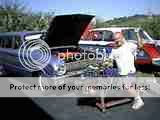Thought I would share my recent experience swapping a Holley 5200 for a Weber DFEV:
1. The main difference that I see between the two is that the 5200 has a double auxillary booster venturi, while the DFEV has a single 3.5 mm booster.
This is the only thing that looks like it would affect the flow. It looks like the DFEV booster could be swapped onto the 5200.
2. The 5200 also has small hole at the top of the air horn that I believe is an idle air bleed. The DFEV has a boss for this, but it is not drilled. My 5200 had an 80 idle jet vs. a 45 for the DFEV.
So if you are having to use a huge idle jet on a 5200, you might want to try putting a little RTV sealant over the hole and use a smaller jet.
3. With the 5200 I measured 4.5" of vacuum at full throttle at around 5000 RPM. With the DFEV, this dropped all the way to 1 or 1.5. I was measuring this with a MitiVac, which isn't too accurate at low vacuum levels.
This is much more of an improvement than I expected from the quoted 270 & 320 CFM flow rates for the 5200 and DFEV. So I wonder if I was really getting the 270 out of the 5200. The mid range and top end power is much better. I don't think there is much to be gained with a larger carb, at least not with my C4 trans that won't go above 5000 RPM.
4. Both carbs idled the best with 3/4 turn opening on the secondary throttle. This gives me an idle of about 800RPM in drive, and 1 1/2 turns on the primary idle speed. If I went over 1 1/2 turns on the primary idle speed setting, I got a stumble coming off idle. The adjustment for the secondary speed setting is on the bottom of the carb, but I made an L-shaped screwdriver out of a hex wrench, and I can adjust it with the carb on. You can also try putting a feeler gauge between the stops, to at least see how it works at idle.
5. With the secondary open 3/4 turn at idle, the secondary idle jet has a considerable affect on the idle. I swapped the secondary idle jets until the optimum primary mixture adjustment was 1 1/4 turns.
6. I set the primary idle jet as lean as I could go without getting a stumble off idle.
7. I set the primary main jet as lean as I could go without getting flat spots at part throttle.
8. I set the secondary main jet for best power at full throttle. This was by feel, don't know if this is right on yet.
9. With the stock jetting, the DFEV had a bog at secondary opening, similar to what others have described on this thread. The DFEV tuning kit comes with a double squirter jet (default is single into the primary only).
I tried this hoping to remove the bog, but it didn't help. The secondary squirter just sprays at the same time as the primary, it doesn't shoot more fuel in as the secondary opens, as it would with a Holley double pumper.
10. What seems to help the bog at secondary opening is to have the secondary throttle stop set to 3/4 turn open. I found this out just by luck, when tuning the idle. Now it only bogs if I gun it with a cold engine.
11. The DFEV's primary and secondary use different emulsion tubes. The primary's tube has more and larger holes in it which bleed more air in. That is probably why they use similar main jet sizes even though the secondary must flow more fuel.
12. On the 5200, I used the MitiVac to measure the power valve opening point. It starts to open as the vacuum drops below 5". I think this means that the power valve was closing at high RPM's since the vacuum was all the way up at 4.5". From the routing of the channels, it looks like the power valve only affects the primary.
13. I didn't make any adjustments to the air bleeds.
14.
www.racetep has some good info. They sell a Weber factory tuning manual that has lots of good technical info about how Webers work, but still no step by step tuning guide.
Here are my current settings:
main jet primary 130
main jet secondary 145
air jet primary 165
air jet seconday 160
idle jet primary 45
idle jet secondary 40
primary speed 1 1/2 turns
primary mixture 1 1/4 T
secondary speed 3/4T
Jerry





